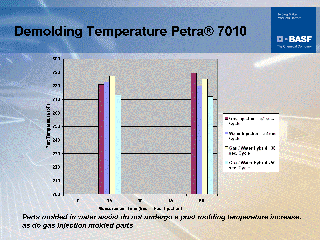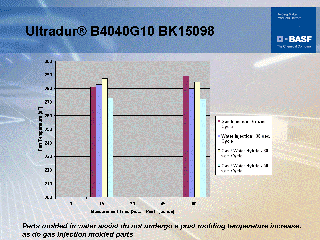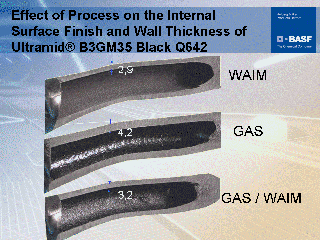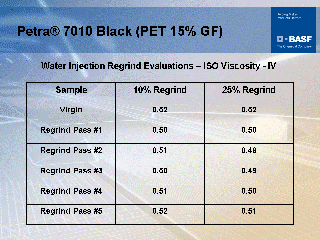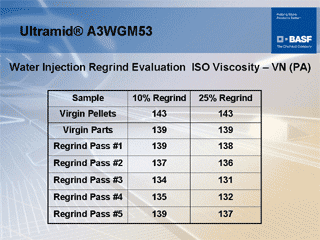By Randy Fleck, BASF
ABSTRACT: This article provides an introduction to the benefits of water-assist injection molding (WAIM), as well as to some of the key differences between WAIM and gas-assist injection molding. A detailed animation quickly introduces the reader to a typical WAIM process, its equipment and configuration. The article also contains links to WAIM-optimized materials and opportunities for more detailed education on WAIM.
Water-assist injection molding (WAIM) is one of the latest and most promising developments in “assisted” injection molding. As in the established gas-assist injection molding process, WAIM technology uses a fluid under pressure to core out a hollow plastic part in the mold. Because of similarities between the two processes, both provide several of the same benefits:
The differences between water and gas, however, enable WAIM to introduce significant improvements of its own:
Molders may also combine gas-assist and water-assist technology in sequence to achieve further benefits in certain applications. Advantages of WAIM Technology Cooling Thinner walls, less material Material surface and performance |
Proven process technology, materials
WAIM has been under development for some 10 to 15 years and is already successfully commercialized in Europe. In North America, BASF Corporation has built upon its European experience and established WAIM technology and application development capabilities. At its Budd Lake, New Jersey, location, the company can perform pilot-scale WAIM, gas-assist injection molding, or the combination of the two processes (GAS-WAIM). BASF has already optimized several resin grades* (LINK) specifically for use in WAIM or GAS-WAIM, and in several product applications.Applications
WAIM is especially well suited for a number of hollow-parts applications:
Automotive fluid handling tubes for oils and coolants
Automotive door handles
Oven and refrigerator handles
Chain saw handles
Office furniture chair arms
Structural components in many industries.
Learn More About WAIM
Every new processing technology comes with a learning curve. Because WAIM resembles gas-assist injection molding, molders already familiar with gas-assist should grasp the intricacies of WAIM most quickly. Before launching a successful WAIM operation, however, some details regarding equipment, process variations, materials and applications (and investment) require explanation and mastering.
Fortunately, several companies in Europe – and now North America – have already done much of the research and development work to ensure this technology’s value and viability. In addition, courses are available to help molders master WAIM.
About the Author
| Randy FleckBASF | Randy Fleck is a Sr. Process Engineer with BASF Engineering Plastics, a global supplier of engineering plastics. He now works in the Advanced Process Technology Group, where the focus is on new process technologies.Prior to that he was a field Technical Development Engineer. Prior to joining BASF in 1991 he worked for 12 years in the injection molding industry in supervision, process engineering, and project management. |
The views, opinions and technical analyses presented here are those of the author or advertiser, and are not necessarily those of ULProspector.com or UL Solutions. The appearance of this content in the UL Prospector Knowledge Center does not constitute an endorsement by UL Solutions or its affiliates.
All content is subject to copyright and may not be reproduced without prior authorization from UL Solutions or the content author.
The content has been made available for informational and educational purposes only. While the editors of this site may verify the accuracy of its content from time to time, we assume no responsibility for errors made by the author, editorial staff or any other contributor.
UL Solutions does not make any representations or warranties with respect to the accuracy, applicability, fitness or completeness of the content. UL Solutions does not warrant the performance, effectiveness or applicability of sites listed or linked to in any content.



